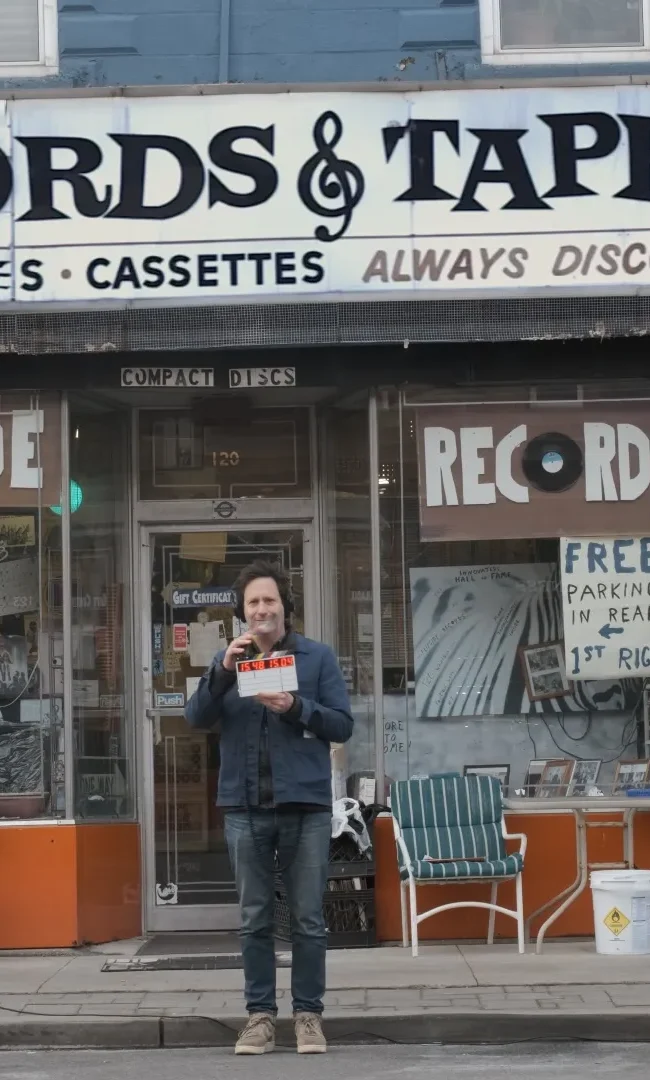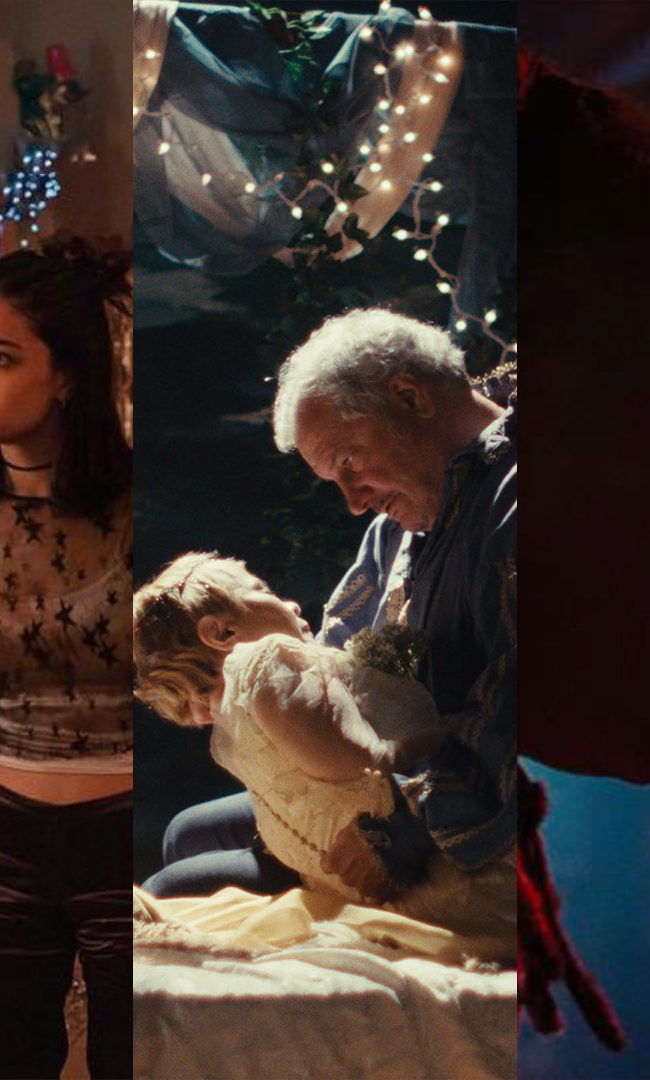A Conversation with Jen Rainin & Rivkah Beth Medow (AHEAD OF THE CURVE)
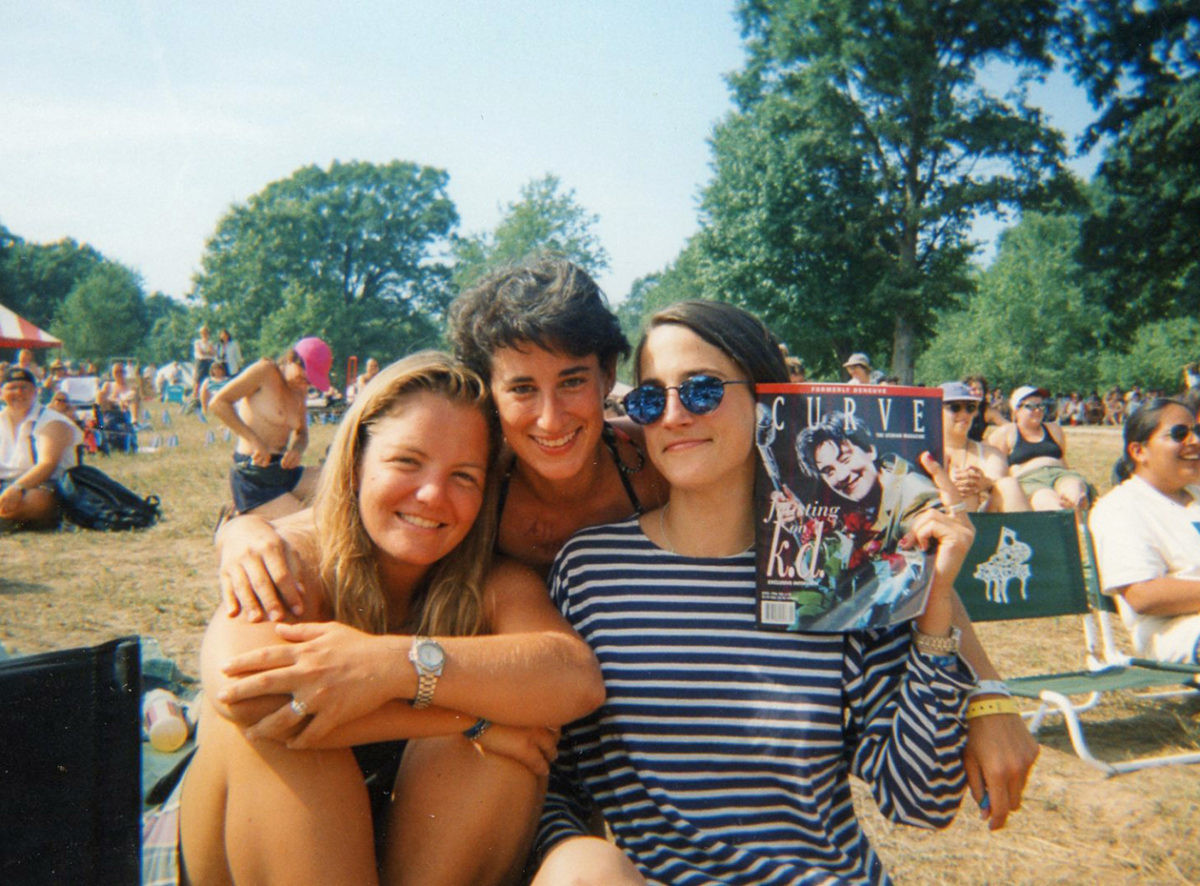
Back in the early 90s coverage of the lesbian community on the new stand just didn’t exist. Frances ‘Franco’ Stevens change that when she founded Deneuve in San Francisco in 1990. Carefully crafting glossy fashion and pop culture and social issues and political journal that she herself wanted to see, Franco was ahead of the curve for the nation on her community but right on time to bring people together cross the globe long before the days of the Internet. After years of reporting on trends and of course probably making them as well, as well as a title shift too Curve Franco found her publication so beloved and so important in the community it served that the number one show on television that dealt with lesbians, The L Word, featured a character whose fictional job was writing for the magazine, a magazine that in the real world was putting the women of The L Word on the cover time and time again. When Franco sold the magazine in 2010 to an Australian media company led by Silke Bader she felt like she had accomplished what she had set out to do. Now 10 years later, as her wife Jen Rainin set out to make the definitive documentary on Franco’s magazine, the documentary subject finds the magazine she spent her life building is having a bit of a crisis in the new world of, dare we say, community acceptance and perceived political equality, and of course the Internet.
I first met director and co-producer Jen Rainin and producer and co-director Rivkah Beth Medow last year when their film played aGLIFF, the All Genders and Lifestyles Identities Film Festival (**editors note: Bears Rebecca Fonte currently serves as Artistic Director at aGLIFF) where in the wake of the pandemic I was serving as the technical director and recording 25 or so Q&A’s. I caught up with them last week to talk about Ahead Of The Curve, and the ability to handle the curves the road of documentary filmmaking always seems to give you.
Hammer to Nail: So, it’s interesting. I rewatched the film because I hadn’t seen it for a while, and then I was like, “Well, what’s going on with the magazine right now?” And I went to the website and I was like, “Oh, there’s some new news.” So, basically, since we last spoke and since the film was finished, I guess the handover back to Frank has finished and Curve has now been relaunched as a foundation. When did you know that was happening in the course of making this film? And it must be very hard as a documentary filmmaker to end the film and then have something else happen.
Jen Rainin: We certainly had no idea when we started filming that this was going to be the outcome at all, but I think when Frank did get that call from Silke Bader, who was the owner of the magazine at the time saying, “Ack, it looks like the magazine, the publication probably won’t be in business in a year. Can you help me think through what it might be?” Silke suggested possibly one option might be that we could turn it into a foundation. So in tandem with Franco’s journey out into the world to ask what’s needed within the community now, and how might Curve continue to serve, we also behind the scenes, put together an advisory council and went out on our own and started thinking about, “Well, let’s check out the feasibility of creating a foundation. Is there really a need for a foundation? If so, what might that look like?”
Rivkah Beth Medow: We were already at least two years into making the film. Franco had come to that conclusion [about the foundation] by the end of the film. It was just this last January where the opportunity for the foundation then to reacquire Curve Magazine arose. So we had already premiered the film. Although we did that weekend, remember, we did a bunch of filming as soon as it became clear.
JR: We literally filmed just because we could, because we are filmmakers. We filmed the decision-making process between Franco and myself about, “Well, do we buy this magazine back for the foundation? What does that look like?” The day before the Glass Fire in Calistoga near Napa, and so we were there at that time and we saw it as a sign like, “Well, this is such a huge idea.”
HtN: You’ve set the world on fire, again. Is it too soon to make jokes about that? So it seems like there was one sense of what this film would be when it started, and then it becomes a little more soul searching and a little more talking about what it means to be a lesbian right now versus what it means to be queer and how those interchange together, which I think is really interesting. Was it hard for you to let one version of the film go and just embrace a new version of the film and what did that mean in terms of planning? And obviously, it meant doing a lot more filming, which is great for the budget.
RBM: You ask such good questions. I will say Jen had been working on the film for long before I joined it. When I came on, one of the things that I knew that would be important is to figure out some way, Jen and I talked about it a lot, how do we connect this historical story with relevance today. But when Silke made that call to Franco and there was this opportunity to then tell that story through the film and there was a lot of complexity and figuring out how we were going to do that, we more than doubled our filming days. So it had a lot of budget impacts and then we weren’t sure how we were going to weave the stories together, but we knew that in our guts, it would be a much more relevant story if we could crack it. We just knew that so many of the seeds of the conversations that we’re having now had been planted early on in the magazine. Curve covered so much in the early 90s, covered everything from marriage equality really early, conversation adoption, trans women really early. Then it would get picked up in mainstream media and then we’re all having those conversations, even 20, 25, 30 years later, so yeah.
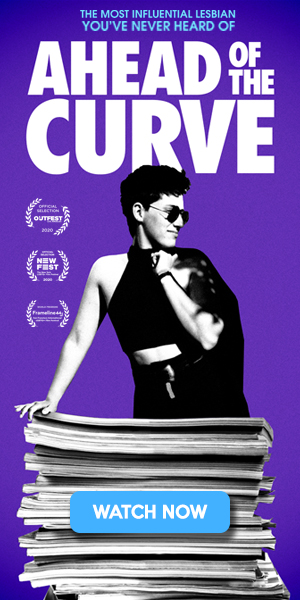
HtN: It’s a better film for it. The thing that’s amazing about what Franco did that you can’t really appreciate unless you were there, is how revolutionary and how important it was, and how groundbreaking it was, because that had not happened before. And we can’t really appreciate that now because it just feels like, “Oh, look, a lesbian magazine. That’s cool.” And unless you were there, unless it was that big of a deal, but to have to re-examine what that means and whether it still is important, then it brings those issues back up and it gives people an opportunity to talk about what it meant when they discovered it and also what those terms mean. I think the scene that you all filmed at the convention where you had the people raise their hands about what words they identify with, to me, that is such a great scene. I think actually, it a little bit of courage to film that and to have that part of it, because you are essentially asking, “Is the movie we’re making relevant? Is our topic relevant?” Which is a frightening thing.
JR: Well, and you see that fear in Franco. Heading in like that, she really didn’t think people would show up even to that panel because she thought, “Younger queer folks, they don’t care. They don’t need to even talk about these words anymore because they don’t even identify with the word lesbian anymore. I’m a fossil.” She really was like, “I just don’t know” and she was shocked in a very positive way to see that room was packed.
Htn: It’s good to know your history. I think that especially – I make this argument all the time – when you are the member of an ethnic minority group, you are being brought up in a history. Your parents are teaching you who you are and what that learned experience is. When you are queer, it’s very likely that no one is teaching you that shit because your parents are going to yell at you when you come out to them and tell you that you’re the devil. Who are you going to learn from? So then you have to make a new family and eventually, we’re going to step away from those people who lived those experiences, and we’re going to get to people who don’t know what it was like to fight for marriage equality or what that day in 2015 meant.
JR: Absolutely and really what we saw we have seen over and over is young people are responding really, really, really strongly to this film because they’re craving that understanding of their lineage, where they came from for exactly the reasons you’re saying, because we have to pass that down…we have to get that information, that knowledge base from somewhere, it’s got to come from us. It’s really powerful to see how young people are responding to this story.
RBM: Language is an evolving idea, and we get to express ourselves in so many different ways and one expression, my identity doesn’t negate someone else’s identity. We talk about that with pronouns where there’s…I have a couple of kids they’re 10 and 12 and a lot of their friends shift their pronouns on the regular. So you’ve got to ask all the time and especially here in California, people feel much more comfortable going outside the binary being really fluid.
HtN: It feeds back into one of the things that I thought you guys talked about so well in the film – and that Curve and Deneuve did so well – which was that all the bodies are different and all the people are different and ‘lesbian’ didn’t mean any one thing. I feel like that’s an issue that I would say a lot of gay magazines still have in a way that it seems like it was solved in the lesbian magazines. There was an openness to different body types and race much faster and sooner and more inclusivity. That seemed like an instinctive thing that Franco had.
JR: Franco was irritated that there was any kind of dis-valuing, that’s not a word, but I’m using it that way, of anyone within the community. She was super frustrated, I think in the late 80s, early 90s, that for example, fem women were not considered part of the community. They weren’t considered lesbians. Like she says in the film, you had to look a certain way. They used to have short hair, couldn’t wear makeup. If you wore heels, obviously not a lesbian, just starting right there. And just the idea that by our nature, as lesbians, as queer women, we’re embracing, we are nurturing and welcoming an inclusive community. She wanted to celebrate the entirety of the community. So she very intentionally was incredibly inclusive from the earliest days in the magazine and it got, I think, much better over time as well.
RBM: When she was making this magazine, it was really a place for every lesbian, every queer woman to feel like they belonged, and they were seen. At some point, Deb St. John talks about, “A lot of women didn’t feel very good about themselves, put down by family, put down by our culture” and this was a place where Jen and I always talk about let much like the magazine, Franco made her magazine both to reflect the beauty of lesbian community back to itself. It was in community, but also to reflect it out to the mainstream and say, “Hey, this is…” Male dominant culture had one idea of what lesbians were and it was usually pretty derogatory. You can see the history of it in cinema and Franco was fighting that, and she knew she wanted everyone to feel like they were beautiful, and they belonged no matter what they look like.
HtN: Okay, so the longest remaining question about the early years of the magazine, is the origin of the name, which is one of the funniest parts of the film. But that actress sued Franco. Did you ever think about reaching out to Catherine –
JR: Catherine Deneuve?
HtN: Yeah. Because –
JR: Well, yes. We sure did.
RBM: We got so close. Tell the story of how close we got.
JR: I actually had a friend of my dad’s who found herself at a dinner party with Catherine Deneuve, but she knew about the film and she walked right up and said, “Ms. Deneuve, hey, do you know about this film being made about Curve Magazine? I understand that you played some role in that and they would love to connect with you to talk about it.” And Ms. Deneuve went – [she makes a slow turn away from the camera]
HtN: Oh, yeah.
JR: Wanted nothing to do with that.
RBM: Yeah, she just turned her back. I think we were texting with the friend and she was, “I’m going to walk up to her right now.” We are like, “Do it, do it.”
HtN: She’s sort of a reprehensible person anyway. She was all like, “The Me Too movement is going too far.” I’m not surprised that she was a jerk about her name. On top of being so arrogant to assume that it must be about her even if it was.
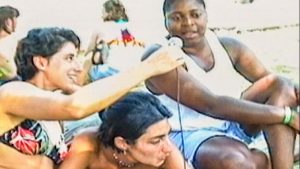
A still from AHEAD OF THE CURVE
JR: The thing that kills me…if Catherine Deneuve had an opportunity here, she could have told her side of the story. She could have said anything. I think a lot of people would have softened their stance toward her if she had said something like, “Hey, it wasn’t my idea. I was forced into it by my people or there was such homophobia at the time and the people felt it would be bad for my career even though —
HtN: The Hunger, that’s an amazing movie – so embrace it. Certainly Susan Sarandon has found a way to talk about that film and Rocky Horror Picture Show in a way that you know where she stands. I feel like maybe it’s a French thing. I don’t know.
RMB: I don’t know. I think it’s a her thing because she could have engendered a ton of empathy. She’s middle age, her career and she could have talked about that. I’m sorry that she didn’t, but after the Me Too letter, I think it’s clear where she positions herself with other women.
HtN: Was there anybody else that you really wanted to get to be on camera that you couldn’t get that is a dream list thing that?
JR: Wow, that’s a good –
RBM: We really wanted Lily Tomlin because there’s this amazing story of Lily Tomlin calling Franco and Franco is in the bathroom and Lily Tomlin was like, “It’s just not the right time,” which is crushing. We had a long list and I think we had some really starry eyes. We made a list of all the women who are on the covers of Curve and Deneuve over the years and we reached out to every single one of them.
JR: Can I just tell one tiny little story here? So, the first celebrity who agreed, getting to that yes was a little bit of an adventure. We had made our list. And Martina Navratilova was the first person on the cover after the magazine switched from Deneuve to Curve. So one night I took a deep breath after a long day and I carefully composed my email to Martina’s manager and said, “Would Martina ever consider…being interviewed for this film?” And I went to sleep and I woke up early the next morning and there was an email in my inbox that said, “I am not now nor have I ever been Martina’s manager.” I’m freaking out and then I did a little forensics and realized, ‘oh my God, I had accidentally sent it to Melissa Etheridge’s manager.’
HtN: Oh my God.
JR: After I died a little inside and I quickly composed that, “Oh my gosh. Oh my gosh. It must’ve been the evil email gremlins or something that did magic, the horrible things to my email. I’m so sorry. But really, we were going to reach out to Melissa also because she was on the cover of the magazine a bunch of times and it would be so amazing.” So 15 minutes later, he turned around and said, “Oh yeah, Melissa says yes.”
RBM: Melissa was the first one to say yes to Franco for the cover. We’re like, “Kismet, sorry.”
Ahead Of The Curve is out now theatrically in apple and Prime Video and Google Play in any number of other sources.
– Bears Rebecca Fonté (@BearsFonte)








